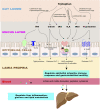New Insights Into Gut-Bacteria-Derived Indole and Its Derivatives in Intestinal and Liver Diseases
- PMID: 34966278
- PMCID: PMC8710772
- DOI: 10.3389/fphar.2021.769501
New Insights Into Gut-Bacteria-Derived Indole and Its Derivatives in Intestinal and Liver Diseases
Abstract
The interaction between host and microorganism widely affects the immune and metabolic status. Indole and its derivatives are metabolites produced by the metabolism of tryptophan catalyzed by intestinal microorganisms. By activating nuclear receptors, regulating intestinal hormones, and affecting the biological effects of bacteria as signaling molecules, indole and its derivatives maintain intestinal homeostasis and impact liver metabolism and the immune response, which shows good therapeutic prospects. We reviewed recent studies on indole and its derivatives, including related metabolism, the influence of diets and intestinal commensal bacteria, and the targets and mechanisms in pathological conditions, especially progress in therapeutic strategies. New research insights into indoles will facilitate a better understanding of their druggability and application in intestinal and liver diseases.
Keywords: indole; indole derivates; intestinal inflammation; liver diseases; tryptophan metabolites.
Copyright © 2021 Li, Zhang, Hu and Zhao.
Conflict of interest statement
The authors declare that the research was conducted in the absence of any commercial or financial relationships that could be construed as a potential conflict of interest.
Figures



References
-
- Alexeev E. E., Lanis J. M., Kao D. J., Campbell E. L., Kelly C. J., Battista K. D., et al. (2018). Microbiota-Derived Indole Metabolites Promote Human and Murine Intestinal Homeostasis through Regulation of Interleukin-10 Receptor. Am. J. Pathol. 188 (5), 1183–1194. 10.1016/j.ajpath.2018.01.011 - DOI - PMC - PubMed
-
- Arnoriaga-Rodriguez M., Mayneris-Perxachs J., Burokas A., Perez-Brocal V., Moya A., Portero-Otin M., et al. (2020). Gut Bacterial ClpB-like Gene Function Is Associated with Decreased Body Weight and a Characteristic Microbiota Profile. Microbiome 8 (1), 59. 10.1186/s40168-020-00837-6 - DOI - PMC - PubMed
Publication types
LinkOut - more resources
Full Text Sources
Other Literature Sources

